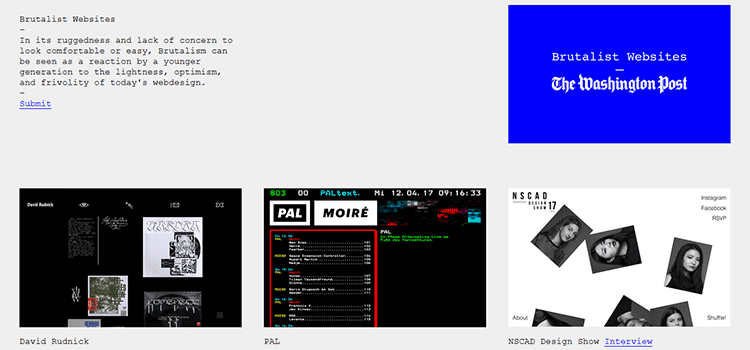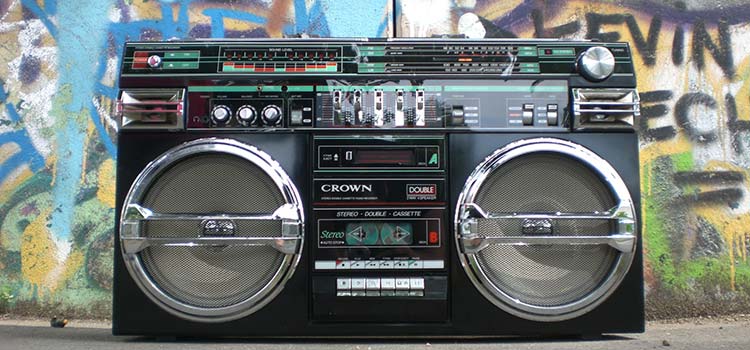Many aspects of pop culture are cyclical. Just as an example: There was a time in the 1980s when skinny ties were very popular. By the 90s, you’d be mocked for wearing one. These days? Well, they’re back in style. As the saying goes – everything old is new again.
That’s what makes the rise of brutalist web designs all the more interesting (and even somewhat appropriate). If we want to bring retro to the web, then let’s go to back to a time when the web was young and not so squeaky clean. At least that’s the theory.
But, do we really want to go back to those days? Let’s dig a little deeper and see if this old-school style is really here to stay or just a passing fad. Beyond that, we’ll ask the question of whether brutalism is even good for the web.
Don’t Call it a Comeback
Of course, when talking about 1990s-era web design, we conjure up memories of some awful (but sometimes necessary) practices like table layouts, blinking text and loading 90k images on a 14.4kbps modem (which, for the record, never downloaded files anywhere near that speed).
Brutalism eschews the tables and can utilize all the advanced CSS techniques designers have in their fancy modern toolboxes. In that way it’s more of a rebellious state-of-mind than a cobbled together collection of HTML hacks.
That leads to designs that may resemble what you may have encountered on GeoCities back in the day, but miles away from that in terms of functionality and browser compatibility (no proprietary IE code needed). It’s another case of modern tools being used to bring back an old style.

Still Just a Rat in a Cage
As someone who started out as a web designer in the 90s, I am somewhat amused when looking at some of the more, ahem, brutal of the brutalist sites out there. I often wonder if these sites were designed by fellow 90s-era designers, or if it’s simply a case of millennials discovering a long-lost technique for the first time.
Back then, many rough designs were the result of relatively low-tech tools and designers (like me) who didn’t know better. In a time before WYSIWYG editors and web-specific graphic optimization, designs were a bit more hand-crafted. Typography was limited to just a few fonts. CSS wasn’t even around until the middle of the decade. In essence, things were rough because they had to be.
That’s why it’s so fascinating to see this type of look come back into fashion. What used to be a limitation for all is now a form of creative expression for some.

Are You Gonna Go My Way?
I can see the benefit of some of the more simplistic aspects of brutalism (basic text listings, really big headlines, etc.). However, I can’t imagine many businesses wanting to brand themselves with crazy backgrounds or color schemes. The more outlandish elements we’re seeing seem to be anything but practical for everyday use.
Right now, it appears that many are utilizing it simply to stand out and as a rejection of the clean, corporate designs we have come to expect. The problem is that these types of trends usually reach a saturation point. After all, if everyone you know is doing the same thing, standing out becomes that much more of a challenge.
In my view, that leads to brutalism becoming more of a niche style, once the initial hype cools down. While the style lends itself well to certain types of sites, it’s hard to see a long-term shift for the web at large.

Don’t Look Back in Anger
Even if full-on brutalist sites don’t hit the mainstream, there are some positive lessons to be learned from them:
Simple is Better
We designers often outsmart ourselves when it comes to layouts and information architecture. Sometimes in the rush to do something clever, we end up making things more difficult for users. Simple layouts and content are quite often the better option.
It’s Good to be Different
At times, web design tends to get a bit buttoned down and predictable. Adding a little bit of unique personality can go a long way towards making something memorable.
We’ve Come a Long Way
Looking at brutalist sites has reminded me of just how far technology and design have come together. We are no longer limited by lousy tools or a lack of standards. Web designers are free to create pretty much any type of look or functionality they please. We’ve never had it so good.
So, while the whole brutalist movement isn’t necessarily for everyone, it does bring an outpouring of opinions – as well as a lot of memories of days gone by.
‘90s Hits Referenced in the Headlines Above:
- LL Cool J – “Mama Said Knock You Out”
- The Smashing Pumpkins – “Bullet with Butterfly Wings”
- Lenny Kravitz – “Are You Gonna Go My Way”
- Oasis – “Don’t Look Back in Anger”
Related Topics
Top